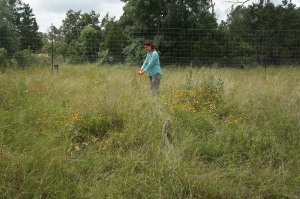Texas State San Marcos Forensic Anthropology Research Facility (FARF, aka “Body Farm”)
I’ve had a busy several days here. Dr. Daniel Wescott, director of the facility, and Dr. Deborah Cunningham have been very welcoming and they have some really nice facilities.
The weather’s been threatening rain, so I set up my precipitation samplers with the assistance of Texas State grad student Brittany McClain. We also collected several soil cores in the sticky Texas clay. We’re collecting rainwater and soil to see what elements and isotopes might be exchanging with the different tissues I’m studying. I want to understand how well the isotopic signatures before death are preserved, so I need context about the soil and water.
The students here at Texas State collect samples of DNA, hair and fingernails from donors when they arrive. Yesterday, I collected a number of hair samples from bodies that have been outside for various periods of time, from a few days to six months. I’ll be able to compare hair when they first arrived to now, to see how the chemical signatures evolve.
If you’re interested in reading about a real-life example where this type of analysis provided crucial help to identify a victim, you can read more about it here. The case mentioned in that link was particularly interesting because isotopic changes along the length of the hair suggested frequent moves between regions. I’m hoping to provide some of the basic research to determine if these isotopic signatures are robust.
A quick note – there will be no graphic pictures on this blog. The donors and their families have done an incredible service to society by allowing us to study them, and everyone I’ve met involved with this type of research is concerned with protecting donors’ privacy and respecting them for their gift to research and science. People can pre-register for full-body donation at FARF.

Reply